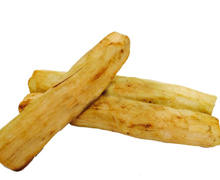
- Address : P.O. Box 11, Gannoruwa rd, Peradeniya, Sri Lanka
- E- Mail : director.hordi@doa.gov.lk
- Telephone :(+94) 081-2388011-12-13
- Fax :(+94) 081-2388234

Kohila
Lasia spinosa
Kohila leaves and rhizomes are popular and nutritious foods. It is good for hemorrhoids and stomach aches as it is rich in fiber.
Available Types
There are two types of kohila.
Local kohila: The leaf is not divided into many segments. Growth is slow and yields are low. Rhizomes are relatively small and less fleshy.
Exotic Kohila: The leaf is divided into many segments. It shows higher growth rate and higher yield. Rhizomes are larger than the local variety and it is fleshy.
Climatic requirements/ Areas suitable for cultivation
Cultivation is suitable with shady environment.
Soil
Only in places where the soil is frequently waterlogged. Kohila is a suitable crop for wetlands. Therefore, it is advisable to have shade for this crop. When there is no shade, the leaves are small.
Field preparation and planting
In a muddy place, destroy the weeds from time to time by ploughing the soil to a depth of 20-25 cm (8-10 inches) and drain the water in places where excess water is retained. Make beds about 5 feet wide and be sure to log them with water when needed and bury a few rows of stalks in the soil at regular intervals.
Cultivation time
Cuttings can be grown throughout the year according to the prescribed environmental conditions.
Planting material
Apex cuttings 20 – 25 cm. (8-10 inches) in size are.most commonly used for planting. Lateral shoots from kohila stems can also be used after the maturation.
In addition, shallow burying of stems in beds arranged in a shady place in the mud allows the shoots to emerge and more shoots are available in a short period of time ready for planting.
Spacing
In a muddy place, destroy the weeds from time to time by ploughing the soil to a depth of 20-25 cm (8-10 inches) and drain the water in places where excess water is retained. Make beds about 5 feet wide and be sure to log them with water when needed and bury a few rows of stalks in the soil at regular intervals.
Fertilizer
Apply organic fertilizer.
Before starting the cultivation, apply various decomposed organic fertilizers and green manures to the beds and mix. Proper application of organic manure helps in conserving soil moisture and increasing soil fertility. Applying cattle manure as an organic fertilizer has the potential to increase the incidence of weeds.
Chemical Fertilizer (Kg / 100m2 )
Fertilizer application | Urea | TSP | MOP |
Basic fertilizer | 1.0 | 1.5 | 1.0 |
4 weeks after top dressing | 1.0 | 1.0 | – |
after each harvest | 1.5 | – | 1.5 |
Note 1: It is best to apply phosphorus and potassium as basic fertilizers after a soil test.
Water supply/ Irrigation
Although moisture is required in the crop, prolonged exposure to water impairs growth. Therefore, necessary steps should be taken to irrigate the crop from time to time.
Weed Control
The main problem of kohila cultivation is the difficulty of weed control. After planting the shoots or buds, apply straw as a mulch to cover the ground. Weeds can also be controlled by applying mulch from time to time at different stages of the cultivation.
Pest Management
Disease Management
Causal Organism: Fusarium sp.
Symptoms:
Surface of the tuber become rot. Leaf yellowing can be seen
Management:
Remove water from the bed and add lime (40g / 1sq root) or add fungicide like Homai / Captan or Thiram according to the description attached with the pack
Causal Organism: Ralstonia solanacearum
Symptoms:
Tubers become rotten. Inside of the tuber become brown in colour. Oozing can be seen when put into water
Management:
Remove infected plants and add lime (After removing of water)
Harvesting
Leaves can be harvested about 8-12 months after planting. About 2,000 – 2,500kgs of rhizomes can be taken as harvest from 50m2 area and about 150 bundles of leaves at a time.
